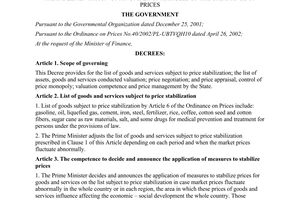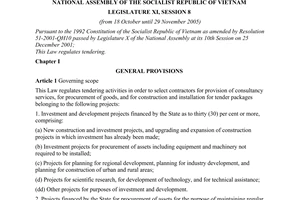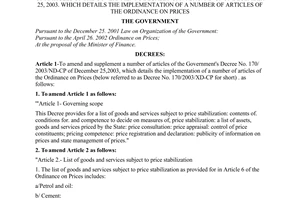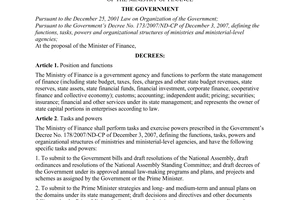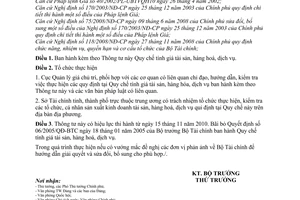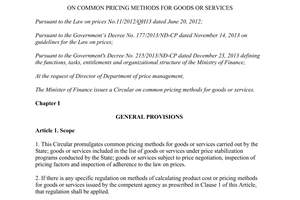Circular No. 154/2010/TT-BTC promulgating the regulation on the pricing đã được thay thế bởi Circular No. 25/2014/TT-BTC common pricing methods for goods or services và được áp dụng kể từ ngày 15/04/2014.
Nội dung toàn văn Circular No. 154/2010/TT-BTC promulgating the regulation on the pricing
|
THE
MINISTRY OF FINANCE |
SOCIALIST
REPUBLIC OF VIET NAM |
|
No. 154/2010/TT-BTC |
Hanoi, October 01, 2010 |
CIRCULAR
PROMULGATING THE REGULATION ON THE PRICING OF ASSETS, GOODS AND SERVICES
Pursuant to April 26, 2002
Ordinance No. 40/ 2002/PL-UBTVQH10 on Prices;
Pursuant to the Government's Decree No. 170/2003/ND CP of December 25, 2003,
detailing a number of articles of the Ordinance on Prices;
Pursuant to the Government's Decree No. 75/ 2008/ND-CP of June 9, 2008,
amending and supplementing a number of articles of Decree No. 170/2005/ND-CP of
December 25, 2003, detailing a number of articles of the Ordinance on Prices,
Pursuant to the Government's Decree No. 118/2008/ND-CP of November 27, 2008,
defining the functions, tasks, powers and organizational structure of the
Ministry of Finance.
Article 1. To promulgate together with this Circular the Regulation on the pricing of assets, goods and services.
Article 2. Organization of implementation
1. The Price Management Department shall assume the prime responsibility for. and coordinate with concerned agencies in. directing, guiding and inspecting the implementation of the Regulation on the pricing of assets, goods and services promulgated together with this Circular and relevant legal documents.
2. Provincial-level Finance Departments shall inspect the observance of this Regulation by organizations and individuals producing and trading in assets, goods and services in their respective localities.
Article 3. This Circular lakes effect on November 15, 2010. The finance Minister's Decision No. 06/2005/QD-BTC of January IX. 2008, promulgating the Regulation on (he pricing of assets, goods and services, is annulled.
Any problems arising in the course of implementation should be reported to the Ministry of Finance for settlement guidance and appropriate amendment and supplementation
|
|
FOR
THE MINISTER OF FINANCE |
REGULATION
ON THE PRICING OF ASSETS, GOODS AND SERVICES
(Promulgated together with the Finance Ministry's Circular No.
154/2010/TT-BTC of October 1, 2010)
Chapter I
GENERAL PROVISIONS
Article 1. Scope of regulation
1. This Regulation provides for the principles and methods of pricing assets, goods and services In be priced by the Stale: and goods and services on the lists of those subject to valorization, price registration, declaration or negotiation according to law,
2. In case competent agencies issue specific regulations on the pricing of assets, goods and services on the lists defined in Clause I of this Article, such regulations prevail.
Article 2. Subjects of application
1. Enterprises, cooperatives, organizations and individuals producing and trading in assets, goods and services (below referred lo as production and business organizations and individuals) specified in Clause I. Article 1 of this Regulation shall base themselves on this Regulation 10 prepare price plans and conduct price consultation, registration and declaration; and report on pricing plans for goods and services on the list of those subject to control of price constituents upon requests of competent state management agencies according to the law on price management.
2. Pursuant to this Regulation, competent price management agencies shall:
a/ Decide on prices; appraise and approve pricing plans; and hold consultation on prices of specific assets, goods and services according to their competence.
b/ Examine price consultation dossiers and price registration and declaration documents.
c/ Control production and circulation costs: control price constituents of assets, goods and services on the list of those subject to control of price constituents upon occurrence of abnormal fluctuations in the market prices of these assets, goods or services according to law or instructions of the Prime Minister, ministers or provincial-level People's Committee chairpersons.
3. Organizations and individuals producing or trading in assets, goods and services other than those specified in Clause I. Article I of this Regulation may apply this Regulation to calculate and fix specific prices for assets, goods and services lo be priced by themselves.
Article 3. Principles of pricing assets, goods and services
1. Accurate and sufficient calculation of actual and reasonable production and business costs associated with the quality of assets, goods and services: conformity with regimes, policies, econo-technical norms and cost norms prescribed by competent agencies.
2. Conformity with supply-demand relations of assets, goods and services in the market and the purchasing power of the Vietnamese currency.
3. Conformity with domestic, regional and world market prices and competitiveness of assets, goods or services at the time of pricing.
4. Conformity with the State's socio economic development policies applicable nationwide or in each region or locality.
Chapter II
METHODS OF PRICING ASSETS, GOODS AND SERVICES
Section I. COMPARISON METHOD
Article 4. Definition
1. Comparison method means a method of pricing a to-be-priced asset, goods or service by analyzing and comparing its price and economic and technical characteristics with great impacts on its price with those of similar assets, goods or services which are traded in the domestic market and. at the same time, referring to regional and world market prices.
2. Similar asset, goods or service means an asset, goods or service of the same type with, identical or similar to the to-be-paced asset, goods or service regarding basic properties such as utility, econo-technical characteristics, shape, size, structural principles, major technical parameters, quality, origin, time of manufacture, production technology and legal characteristics.
3. Comparable asset, goods or service means a similar asset, goods or service with successful sale and purchase transactions in the market which is selected for price analysis, comparison and readjustment based on its elements which can be compared with those of the to-be-priced one.
4. Comparable elements means elements with great impacts on the value of the to-be-priced asset, goods or service, including: trading price. time and conditions (market conditions, sale and purchase conditions, payment conditions and modes); basic properties of assets, goods or services such as legal characteristics, utility, characteristics, major technical parameters, production and circulation costs, quality, origin, time of manufacture and use duration.
Article 5. Pricing bases
1. Successful trading prices of similar assets, goods or services in the market at the time of pricing or a time closest to the time of pricing. Specifically:
a/ For a similar asset, goods or service which is produced or imported for circulation in the domestic market, the successful trading price is the prevailing price determined based on information acquired from such sources as sale invoices or pricing decisions issued by competent organizations or individuals: the import price indicated in customs declarations or supplied by customs offices: the bid- or auction-winning price or registered or declared price: the posted price: the price indicated in price quotations or the price determined by a price appraisal organization. In case there are few assets, goods or services similar to the to-be-priced ones which are circulated in the market and. therefore, no common price is available, the trading prices or bid- or auction-winning prices of these similar assets, goods or services at a time closest to the time of pricing may be used.
b/ For a similar asset, goods or service circulated in the regional or world market, it is the prevailing price determined based on information collected from the following sources: information on the selling price of such asset, goods or service in the regional or world market collected via the internet, mass media and overseas Vietnamese commercial representations, bidding and auction results, price quotations, price offers and actual transactions of organizations and individuals.
All collected data must have their sources clearly slated and reflected in pricing plan dossiers.
3. Brands of assets, goods or services.
4. Normal commercial conditions and generally accepted commercial practices in the domestic, regional and world markets for similar assets, goods or services.
5. Results of price analysis, comparison and adjustment based on comparable elements of similar assets, goods or services used for pricing the to-be-priced asset, goods or service.
Article 6. Pricing steps
Step 1. Collecting information
To conduct market survey and collect information on the prevailing price of each similar asset, goods and service in the market at the time of pricing or a time close to the lime of pricing and select at least 3 comparable assets, goods or services; to collect necessary information relating to the to-be-priced asset, goods or service and comparable ones.
Step 2. Analyzing and selecting appropriate comparable elements: making an analysis and comparison table for each comparable element
When selecting comparable elements, it is required to choose those with the greatest impacts on the prices of assets, goods or services and. at the same time, select comparison units suitable or chair or units of measurement such as kilogram to basic properties of assets, goods or services (kg), ton, meter (m), square meter (m2) or cubic (using such product units as piece, patient bed meter (m3)).
Table 1. Price adjustment based on comparable elements
|
No. |
Comparable element |
Calculation unit |
To be-priced asset, goods or service |
First comparable asset. goods or service |
Second comparable asset, goods or service |
Third comparable asset, goods or service |
|
A |
Market price |
|
To be determined |
Already known |
Already known |
Already known |
|
B |
Product unit |
|
|
|
|
|
|
C |
Adjustment based on comparable elements |
|
|
|
|
|
|
C1 |
first comparable element |
|
|
|
|
|
|
Adjustment rate |
% |
|
|
|
|
|
|
Adjustment level |
VND |
|
|
|
|
|
|
C2 |
Second comparable element |
% |
|
|
|
|
|
Adjustment rate |
|
|
|
|
|
|
|
Adjustment level |
VND |
|
|
|
|
|
|
C3 |
Third comparable element |
|
|
|
|
|
|
Adjustment rate |
% |
|
|
|
|
|
|
Adjustment level |
VND |
|
|
|
|
|
|
C4 |
fourth comparable element |
|
|
|
|
|
|
Adjustment rate |
% |
|
|
|
|
|
|
Adjustment level |
VND |
|
|
|
|
|
|
|
… |
|
…. |
…. |
…. |
|
|
|
Total net adjustment value |
VND |
|
|
|
|
|
D |
Adjusted price of comparable assets, goods or services |
VND |
|
|
|
|
|
Number of adjustments |
|
|
|
|
||
|
E |
Price selected for the to he-priced asset. goods or service |
|
|
|
|
|
Step 3. Analyzing and determining the different elements between comparable assets, goods 01 services and the to-be-priced asset, goods 01 service: adjusting the price of each comparable asset, goods or service based on the differences among comparable elements so as to find out a price with regard to such asset, goods or service to serve the pricing of the to-be-priced asset, goods or service
Step 4. Adjusting prices on the following principles.:
- Adjusting the prices of comparable assets, goods or services based on typical characteristics of the to-be-priced asset, goods or service:
- The price shall be adjusted based on the difference of each comparable element while the remaining comparable elements are fixed (considered to be alike). The adjustment level for each comparable element must be supported with information collected in the market. Specifically:
+ The price of a standard unit of a comparable asset, goods or service will be adjusted up (+) for each element worse than that of the to-be-priced asset, goods or service:
+ The price of a standard unit of a comparable asset, goods or service will be adjusted down (-) for each element better than that of the to-be-priced asset, goods or service;
+ Price adjustment based on the difference in comparable elements may be expressed in a specific sum of money or a percentage increase or decrease in the market price of comparable assets, goods or services.
The total net adjustment value of a comparable asset, goods or service is the total of adjustment levels based on each comparable element with a negative sign (decrease) or positive sign (increase).
- Determining the adjusted price of each comparable asset, goods or service which is equal to its original price plus (+) or minus (-) its total net adjustment value.
Step 5. Determining the price of the lo-be-priced asset, goods or service (line 11. table I! which is the price representing the adjusted prices of all comparable assets, goods or services (line I), table 1) or the average of the adjusted prices of all comparable assets, goods or service
The price representing the adjusted price of all comparable assets, goods or services >s the adjusted price of a comparable asset, goods or service which is selected according to the following criteria:
- Being the comparable asset, goods or service with the fewest price adjustments.
- Being the comparable asset, goods or service with the lowest adjustment rate for each comparable element.
- Being the comparable assets, goods or service with the smallest total net adjustment value.
Section II. COST METHOD
Article 7. Definition
The cost method means a method of pricing an asset, goods or service based on actual, reasonable and lawful production and business costs (including both direct and indirect costs) for the production and circulation of such asset, goods or service and the projected profit (if any).
Article 8. Pricing bases
1. Actual, reasonable and lawful production and business costs, which shall be used for determining the cost price or cost of goods sold and the total cost price of a product unit.
Actual, reasonable and lawful production and business costs arc costs necessary for the production and trading of assets, goods or services up to standard technical parameters and quality which arc determined based on regimes policies, econo-technical norms and cost norms prescribed by competent agencies and lawful vouches and invoices in conformity with market prices at the time of pricing or a time closest to the time of pricing
2. The projected profit (if any; per asset, goods or service unit, which shall be used for pricing such assets, goods or services
3. The State's socio-economic development policies in each period
Article 9. Pricing of assets, goods and services
1 For home-made assets, goods and service
The price of an imported asset, goods or service unit shall be determined according to the following formula:
|
Price of an asset, goods or service |
= |
Total cost price (Z) |
+ |
Projected profits ( if any) |
+ |
Excise tax (if any) |
+ |
Value added tax (if any) |
2. For imported assets, goods or services:
The price of an imported asset, goods or service covers the import cost price (Civ) plus ( + ) sale cost, enterprise management cost and other cash costs (if any) plus ( + ) projected profit (if any.) plus {+) value-added lax (if any).
a/ The impost cost price (Gv) shall be determined according to the following formula:
|
Gv |
= |
Buying price at a Vietnam’s border gate (CIF price) |
+ |
Import duty |
+ |
Excise tax ( if any) |
+ |
Other cash costs according to regulation ( if any) |
In which
- The buying price at a Vietnam's border gate( CIF price) is equal to (the actual buying price in a foreign market plus(+) costs incurred overseas for transporting goods to Vietnam( including the original buying price, insurance and overseas transport freights) plus( +) costs to be added to the value of imported goods for import duty calculation according to regulation) multiplied by the foreign exchange rate.
The foreign exchange rate shall be determined based on the actual rate at which the production or business organization or individual made payment to the bank (with which it/he/she has made transaction) upon borrowing or purchasing foreign currencies to purchase goods.
In case an organization or individual has made no payment to the commercial bank from which it/he/she/ has borrowed or purchased foreign currencies, the exchange rate shall be determined based on the selling exchange rate applied by Such commercial bank at the lime of pricing
- Import duty and excise tax (if any) comply with current tax laws.
- Other cash costs (if any) comply with regulations
b/ Sale cost, general management cost and other cash costs shall be determined under Clauses 4. 5 and 6. Article 10 of this Regulation.
c/ Oilier costs (if any) comply with laws.
d/ Projected profits shall be determined under Article 12 of this Regulation.
e/ Value-added lax complies with current tax laws.
Article 10. Determination of production and business costs and total cost prices of assets. goods and services
The production and business cost and the total cost price of an asset, goods and service (below referred to as product) for use as pricing bases shall be determined based on cost elements or items in the table below:
|
No. |
Costs |
Code |
|
A |
Total production or business output |
Q |
|
B |
Production or business costs |
C |
|
1 |
Direct material costs |
CVT |
|
2 |
Direct labor costs |
CNC |
|
3 |
General production costs |
CSCX |
|
|
Production cost/cost of goods sold |
GV |
|
4 |
Financial costs (expenses for payment of loan interests, if any) |
CTC |
|
5 |
Sale costs |
CBH |
|
6 |
Enterprise management costs |
CQL |
|
|
Total production or business costs (from 1 thru 6i |
TC |
|
C |
Costs> allocated to by-products (if any) |
CP |
|
D |
Total cost price of a product unit (TC-CP)/Q |
z |
Each cost above shall be determined according lo current laws. Specifically:
1. Direct material costs (CVT)
Direct material costs are costs for raw materials, materials, fuel and power (below referred to as materials) which shall be determined based on material consumption quantity and material price:
Material cost = Amount of consumed material x Material price
a/ Amount of consumed material shall be determined based on econo-technical norms as follows:
- For products with available econo-technical norms set by competent stale agencies, such norms shall apply.
- For products without econo-technical norms set by competent state agencies, the Boards of Directors or Members' Councils, for enterprises with Boards of Directors or Members' Council, or enterprise directors general (directors) or unit heads shall set econo-technical norms for application and lake responsibility before law for the accuracy of such norms.
b/ Material price shall be determined as follows:
a/ For a product liable to value-added tax calculated by the credit method, material price is exclusive of value-added tax.
b/ For a product not liable to value-added lax or liable to value-added tax calculated by the direct calculation method, material price is inclusive of value-added tax.
- Material price used for pricing a product shall be determined based on the standards, category and quality of used material associated with the place of product manufacture. Specifically:
+ The price of a state-priced material is equal lo the price set by the State plus (+) reasonable circulation costs (if any):
- For procured materials: In case of lacking required vouchers and invoices, the price of a procured material is the lowest among the market price notified by a functional organization, price quoted by the producer or price offered by the supplier. In case vouchers and invoices are sufficient as required, its price is the price of another product of similar standards and quality in the same geographical area (region) or the selling price indicated in goods sale/purchase invoices or the bid- or auction-winning price or the posted price plus (+) reasonable and valid expenses (if any) for transporting such material to the enterprise's storehouse.
The price of a material imported for production is equal to: [the import price (CIF price) plus (+) import duly (+) excise tax. if any] multiplied by (x) the selling rate of the foreign currency set by the commercial bank with which the concerned enterprise has transactions suitable lo the payment method prescribed at Point a. Clause 2. Article 9 of this Regulation, plus ( + ) actual reasonable expenses for transporting such material to the enterprise's storehouse (if any).
+ The price of a self-produced material is the actual ex-warehousing price plus ( + ) costs incurred in the production process (if any).
+ The price of a material the processing of which is outsourced is the actual ex-warehousing price plus (+) processing cost plus (+) reasonable expenses for transporting such material to the enterprise's storehouse (if any).
Material prices and expenses for material processing, transportation, preservation and purchase must be written on invoices and vouchers according to regulations. For materials being agricultural, forestry or aquatic products purchased directly from producers without invoices, the buyer shall make a list of purchased goods clearly indicating the names and addresses of the goods sellers, goods quantity, unit price and total payment. Such a list shall be signed b\ the goods sellers and enclosed w ith a decision of the unit head or the enterprise director general (director) according lo the accounting, statistics and lax and other relevant laws.
2. Direct labor costs (CNC)
Direct labor costs include amounts to be paid to laborers directly engaged in production such as salaries, wages and allowances of salary nature, social, health and unemployment insurance premiums and trade union dues according to the Labor Code, which shall be determined based on labor norms and unit salary or wage.
Direct labor cost = Labor norm x Unit salary or wage
a/ Labor norm
- For products with available labor norms set by competent state agencies, such labor norms shall apply.
- For products without available labor norms, the Boards of Directors/Members' Council, for enterprises with Boards of Directors or Members' Councils, or Directors General (Directors) of enterprises or heads of agencies or units shall set labor norms on the principle of thrift and effectiveness for application and take responsibility before law for the accuracy of these norms.
b/ Unit salary or wage
- The unit salary shall be determined based on the basic salary prescribed by the State, additional salaries, salary-based allowances and contributions (social, health and unemployment insurance premiums and trade unions dues) and other regimes applicable to laborers according to current regulations. The method of calculation, competence to approve and registration of unit salary comply with current regulations.
- For enterprises paying wages under labor contracts or collective labor agreements, their wage costs shall be determined based on labor contracts or collective labor agreements.
3. General production costs (CSXC)
a/ General production costs mean indirect production costs (excluding direct material costs and direct labor costs) arisen in an enterprises workshops and business sections as follows:
- Costs for workshop staffs: salaries and allowances payable to managers of production workshops, sections and teams; mid-shift meal allowances for managers of production workshops, sections and teams; social, health and unemployment insurance premiums and trade union dues calculated in a percentage of salaries payable to these managers according lo current regulations.
- Costs for materials used for workshops such as materials used for repairing or maintenance of fixed assets, tools and instruments of workshops, cost for building makeshift houses.
- Costs for tools and instruments used in management activities of production workshops, sections and teams.
- Costs for depreciation of fixed assets used directly in the process of producing products or providing services and fixed assets used for the operation of production workshops, sections and teams.
- Costs for services purchased to serve activities of production workshops, sections and teams such as those for repair or lease of fixed assets, electricity, water and telephone and amounts payable to sub-contractors (for construction enterprises).
- Cash costs other than the above costs which serve activities of production workshops, sections and teams.
b/ Methods of calculating some costs included in general production costs
- Material cost and labor cost shall be determined according to Clauses 1 and 2 of this Article. For cases in which goods or services are purchased or hired not under the Bidding Law, the prices indicated in economic contracts, contract liquidation records, value-added invoices and other lawful documents in accordance with current laws may be used.
- Costs for depreciation of fixed assets shall be determined under the Finance Ministry's regulations on the management use and depreciation of fixed assets.
4. Sale costs (CBII)
Sale costs include costs (if any) actually incurred during the process of selling goods or providing services:
- Amounts payable to salespersons and packing, transporting and preserving employees, including, salaries, mid-shift meal allowances, wages, social, health and unemployment insurance premiums and trade union dues.
- Costs for materials and packings used for the preservation and consumption of products, goods and services such as those for packing materials, fuels for preservation, loading and transportation of products and goods during circulation and materials for repair and maintenance of fixed assets in sale sections.
- Costs for tools and instruments serving the sale of products and goods such as measuring devices, calculators or working equipment.
- Costs for depreciation of fixed assets in preservation and sale sections such as storehouses, shops, yards, loading and unloading equipment, vehicles, measurement devices, calculators or quality-testing devices.
- Costs for product warranty.
- Costs for external services to serve sale activities such as repairing fixed assets used in sale activities, hiring storehouses and storing yards, loading, unloading and transporting products and goods for sale, paying commissions to sale agents and export entrustment-undertaking units.
- Cash costs other than the above costs arising in sale activities such as those for receiving guests of sale sections, introduction of products and goods and expenses for advertisement or customers conferences.
In ease of availability of econo-Technical norms set by competent stale agencies, regimes prescribed by the State or laws (tax. accounting and statistics and other relevant laws) and prices set by the State for any of the above sale costs, such regulations will apply. For costs without such regulations, chairpersons of the Boards of Directors/Members' Councils or Directors General (Directors) of enterprises or heads of agencies or units shall formulate and approve such regulations according to laws.
For national reserve goods, public-utility services and products and public services ordered by the Slate which arc produced or provided under plans set by the Slate and paid with state budget funds, such costs as those for advertisement, marketing, sale promotion or brokerage and agency commission must not be calculated.
5. Financial costs (CTC)
Financial costs included in price plans are amounts for payment of interests on loans (if any | used for the production and trading of to-be priced assets, goods or services and the foreign exchange rate disparities during the process of purchasing materials and goods and shall be allocated to each unit of such products, goods or services.
For national reserves goods, public-utility products and public services ordered by the Stair which are produced under plans set by the Stale and paid with state budget funds and other assets, goods and services for which all necessary funds are advanced by the Slate or ordering organizations, loan interests must not be calculated.
6. Enterprise management costs (CQL)
Enterprise management costs include:
- Costs for managing staffs, including payments to business managers such as salaries, allowances, social, health and unemployment insurance premiums and trade union dues for executive board members and managers of different sections.
- Costs for materials used in business management activities such as stationery, materials for repairing fixed assets, tools and instruments.
- Costs for office equipment used in business management activities.
- Costs for depreciation of common fixed assets such as working offices of different sections, storehouses, architectural objects, vehicles and conveyance equipment, machinery and equipment for management activities of enterprise offices.
- Taxes, charges and fees such as registration tax. land rents and other fees and charges.
- Provisions (if any) including provisions for bad receivables or liabilities which are accounted as production and business costs of enterprises.
- Costs for external services to serve business management activities; costs for purchase and use of technical documents and innovations (unqualified as fixed assets) which shall be gradually allocated to enterprise management costs; costs for renting fixed assets and payments to sub-contractors.
- Cash costs other than the above costs which are regarded as general management costs such as those for conferences and guest reception, working-trip allowances, travel expenses, expenses for female laborers, research and training expenses, association membership fees and other reasonable expenses.
In case of availability of econo-technical norms, regimes and policies prescribed by competent agencies or laws (tax. accounting and statistics and oilier relevant laws) and prices set by the State for any of the above enterprise management costs, such regulations will apply. For costs without such regulations, chairpersons of Boards of Directors/Members' Councils or Directors General (Directors) of enterprises or heads of agencies or units shall elaborate and approve regulations for application according to law.
7. Cost allocation
Overhead costs and costs directly related to many products, goods and services such as fixed asset depreciation, salaries, social, health and unemployment insurance premiums and trade union dues, sale costs and enterprise management costs which cannot be separated must be summed up and allocated to each product, goods and service by appropriate criteria under the current guidance.
8. Allocation of production costs to by products obtained in the process of producing main products
Production costs shall be allocated to byproducts as follows: Production costs shall be allocated to by-products obtained in the process of producing main products which are sold or further used as raw materials to produce other products, for subtraction from production costs of main products, for by-products which are neither sold nor used, no production cost will be allocated.
Article 11. Expenses not accounted as reasonable expenses for determining cost prices of products
Expenses not accounted as reasonable and lawful expenses for determining cost prices of products comply with current regulations on expenses not allowed to be subtracted when determining taxable incomes for calculation of enterprise income tax and expenses not accounted as production costs and cost prices of products according to relevant legal documents.
Article 12. Projected profits for pricing
1. Pursuant to Article 3 of this Regulation, organizations and individuals producing and trading in assets, goods and services shall project a profit ratio or reasonable profit amount, if any, to ensure that the determined selling price of an asset, goods or service must not exceed its market price (for assets, goods or services with available market prices).
Profit ratio is a percentage % of profits to the total cost price; selling price: equity capital or state investment capital assigned by the owner's representative {allocated to each product, goods or service unit).
2. Methods of determining reasonable profit amounts
a/ In case the to-be-priced asset, goods or service is circulated in the market or there are similar assets, goods or services produced and circulated in the market, the maximum projected profit amount shall be determined as equal to the actual profit amounts (already audited) of enterprises producing and trading in similar assets, goods or services at the latest time or determined based on preceding years" data of the relevant sector or actual figures of the enterprise.
b/ for an asset, goods or service (home-made or imported) produced or provided under I the State's orders or plans which has not yet been circulated in the market or there is no similar asset. goods or service produced and circulated in the market, the projected profit amount, after paying enterprise income tax. must be enough for making deductions for setting up the welfare fund and reward fund according to current regulation or shall be determined based in the actual profit ratio (already audited) at the latest time applicable to another asset, goods and service which the enterprise produces or trades in.
Section III. SELECTION OF PRICING METHODS
Article 13. Selection of pricing methods
On the basis of the property, utilities, practical production and business, market and circulation conditions of each specific asset, goods and service, organizations and individuals may select an appropriate pricing method for making its price plan according to regulations.


